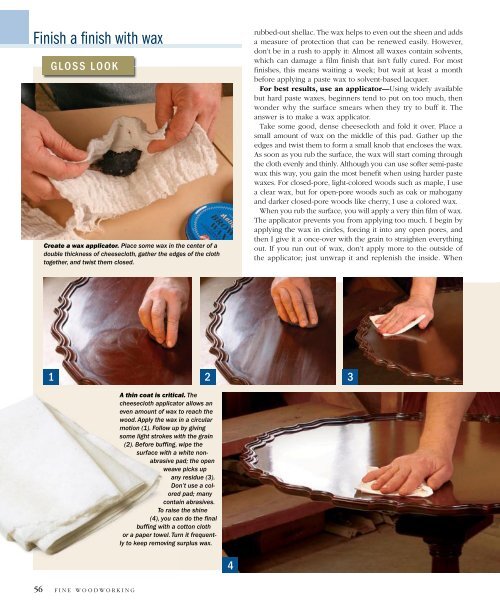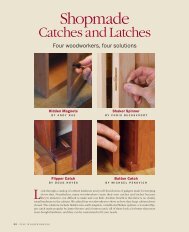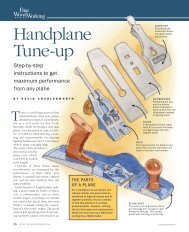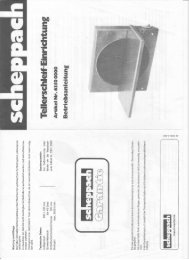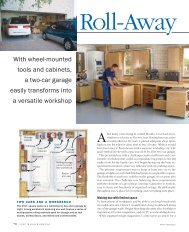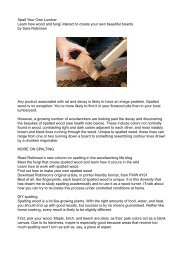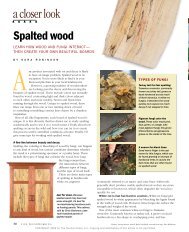Wax Primer
Wax Primer
Wax Primer
Create successful ePaper yourself
Turn your PDF publications into a flip-book with our unique Google optimized e-Paper software.
Finish a finish with wax<br />
GLOSS LOOK<br />
Create a wax applicator. Place some wax in the center of a<br />
double thickness of cheesecloth, gather the edges of the cloth<br />
together, and twist them closed.<br />
rubbed-out shellac. The wax helps to even out the sheen and adds<br />
a measure of protection that can be renewed easily. However,<br />
don’t be in a rush to apply it: Almost all waxes contain solvents,<br />
which can damage a film finish that isn’t fully cured. For most<br />
finishes, this means waiting a week; but wait at least a month<br />
before applying a paste wax to solvent-based lacquer.<br />
For best results, use an applicator—Using widely available<br />
but hard paste waxes, beginners tend to put on too much, then<br />
wonder why the surface smears when they try to buff it. The<br />
answer is to make a wax applicator.<br />
Take some good, dense cheesecloth and fold it over. Place a<br />
small amount of wax on the middle of this pad. Gather up the<br />
edges and twist them to form a small knob that encloses the wax.<br />
As soon as you rub the surface, the wax will start coming through<br />
the cloth evenly and thinly. Although you can use softer semi-paste<br />
wax this way, you gain the most benefit when using harder paste<br />
waxes. For closed-pore, light-colored woods such as maple, I use<br />
a clear wax, but for open-pore woods such as oak or mahogany<br />
and darker closed-pore woods like cherry, I use a colored wax.<br />
When you rub the surface, you will apply a very thin film of wax.<br />
The applicator prevents you from applying too much. I begin by<br />
applying the wax in circles, forcing it into any open pores, and<br />
then I give it a once-over with the grain to straighten everything<br />
out. If you run out of wax, don’t apply more to the outside of<br />
the applicator; just unwrap it and replenish the inside. When<br />
1 2 3<br />
A thin coat is critical. The<br />
cheesecloth applicator allows an<br />
even amount of wax to reach the<br />
wood. Apply the wax in a circular<br />
motion (1). Follow up by giving<br />
some light strokes with the grain<br />
(2). Before buffing, wipe the<br />
surface with a white nonabrasive<br />
pad; the open<br />
weave picks up<br />
any residue (3).<br />
Don’t use a colored<br />
pad; many<br />
contain abrasives.<br />
To raise the shine<br />
(4), you can do the final<br />
buffing with a cotton cloth<br />
or a paper towel. Turn it frequently<br />
to keep removing surplus wax.<br />
4<br />
56<br />
F I N E W O O D W O R K I N G


